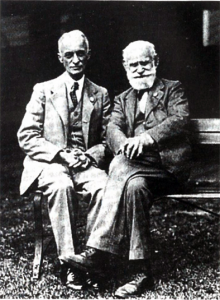
Dr. Cushing, left, with Ivan Pavlov, soon before the beaviorist was mauled and devoured by a dog he teased.
Pioneering Ohio-born neurosurgeon Dr. Harvey Cushing did many great things for mankind, including introducing blood-pressure measurement to America. He did one final great thing for science in 1939, when he bequeathed a large collection of cancerous brains he’d amassed to his alma mater Yale University. Yale did a pretty brainless thing when it allowed the collection and the meticulous notes that accompanied it to fall into disrepair. Thankfully, the invaluable medical remnants are once again in respectable shape after a $1.4 million renovation project. Dr. Randi Hutter Epstein has a good article about the project in the New York Times. The piece also makes it clear that despite Cushing’s talent and preparation, brain surgery during his career was still very much a work in progress. An excerpt:
“Cushing became the first surgeon in history who could open what he referred to as ‘the closed box’ of the skull of living patients with a reasonable certainty that his operations would do more good than harm.
Sometimes doctors went into the brain and could not find the tumor. Sometimes they talked to patients during surgery. Dr. Cushing, for one, often used only the local anesthetic Novocain. (The brain itself does not have pain receptors, but having one’s skull cut open must have been agonizing.) Mr. Bliss writes that in 1910, midway through a 10-hour operation on the renowned physician and Army Gen. Leonard Wood, Cushing wanted to stop operating and continue another day, but General Wood–fully alert–begged him to continue.”

